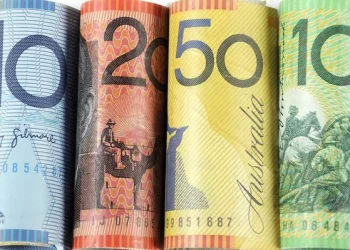The Australian Dollar (AUD) extended its decline against the US Dollar (USD) for a second consecutive session on Friday, weighed down by escalating US-China trade tensions and expectations of a Reserve Bank of Australia (RBA) rate cut. The AUD/USD pair remains under pressure as risk-off sentiment dominates global markets.
US-China Trade Disputes Weigh on AUD
China, Australia’s largest trading partner, retaliated against the latest 10% US tariff, which took effect on Tuesday. While US President Donald Trump indicated he would likely speak with Chinese officials within 24 hours, he also warned that failure to reach a deal would result in “very, very substantial” tariffs. Despite these remarks, no further updates have emerged, keeping markets on edge.
Adding to trade concerns, China’s Commerce Ministry announced new tariffs, including a 15% levy on US coal and liquefied natural gas (LNG) imports and an additional 10% tariff on crude oil, farm equipment, and certain automobiles. Beijing is also imposing export controls on key industrial metals, citing national security concerns.
RBA Rate Cut Expectations Further Pressure AUD
Market sentiment surrounding the Australian Dollar remains weak as traders price in a 95% probability that the RBA will cut interest rates from 4.35% to 4.10% in February. The central bank has maintained the Official Cash Rate (OCR) at 4.35% since November 2023, emphasizing that inflation must sustainably return to its 2%-3% target before any policy easing.
Meanwhile, Australia’s trade surplus fell to AUD 5.08 billion in December, missing the expected AUD 7.00 billion and down from the previous surplus of AUD 6.79 billion. While exports increased by 1.1% month-over-month (MoM), this was a significant slowdown from November’s 4.2% rise. Imports surged by 5.9% MoM, further dampening the trade outlook.
US Dollar Gains on Strong Labor Market Data
The US Dollar Index (DXY) climbed to 107.70 as traders turned cautious ahead of the US Nonfarm Payrolls (NFP) report, which is expected to influence the Federal Reserve’s monetary policy.
US Initial Jobless Claims rose to 219,000 for the week ending January 31, exceeding market expectations of 213,000 and marking an increase from the previous week’s revised figure of 208,000. Additionally, the US ISM Services PMI eased to 52.8 in January, falling short of the consensus forecast of 54.3.
Federal Reserve officials have maintained a cautious stance on rate cuts. Dallas Fed President Lorie Logan stated that while inflation progress has been significant, the strong US labor market means the Fed is unlikely to ease policy soon. Fed Vice Chair Philip Jefferson echoed similar sentiments, emphasizing that the current policy stance remains restrictive.
AUD/USD Technical Outlook: Support and Resistance Levels
Despite recent weakness, AUD/USD remains steady near 0.6290, holding above the nine- and 14-day Exponential Moving Averages (EMAs), signaling short-term bullish momentum. The 14-day Relative Strength Index (RSI) stays above 50, reinforcing a cautiously optimistic technical outlook.
- Resistance: The AUD/USD pair could test the seven-week high of 0.6330, last reached on January 24.
- Support: Immediate support lies at the nine-day EMA near 0.6260, followed by the 14-day EMA at 0.6254. A decisive break below these levels could weaken the bullish outlook, potentially dragging the pair toward the February 3 low of 0.6087—its weakest level since April 2020.
With US-China trade tensions unresolved and the RBA’s rate decision approaching, volatility in the Australian Dollar is likely to persist in the near term.
Related Topics:

























